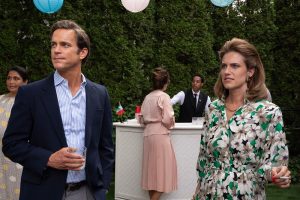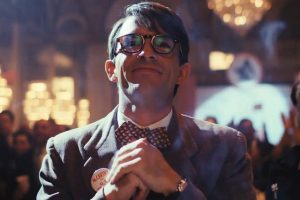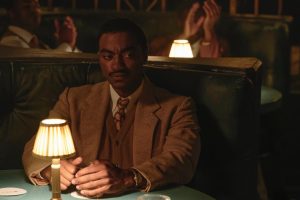The men and women of Showtime’s Fellow Travelers carry many secrets as they roam the halls of power of Washington D.C.. Spanning over three decades from the late 1950s through the dawn of the AIDS crisis, Ron Nyswaner details the lives of those who could never live or love freely as the Lavender Scare took hold with the help of the likes of Roy Cohn and Joe McCarthy. Throughout history, there have been laws dictating how police could arrest and target gay and queer people just for how they dressed themselves in the morning. Costume designer Joseph La Corte, imbues every clothing choice with character, love, and, above all else, unbridled passion.
Like La Corte’s last huge television project, FX’s under-awarded Under the Banner of Heaven, Fellow embraces the size and scope of the story while zoning in on the intimate love story between Matt Bomer’s Hawkins Fuller and Jonathan Bailey’s Tim Laughlin. La Corte used an easy mantra to make his way through production. There was no way that he could say no to this project.
“My agent reached out to me and told me that Ron Nyswaner and Daniel Minahan wanted to talk to me about the project,” La Corte reveals”. I ordered the book on a Friday, and I read it nonstop until I finished it. When we met on Zoom, we had such an open conversation and I knew about the scope of the ’50s. I love doing projects that span decades, and you, honestly, just have to take it a day at a time. Since the weather was not going to be in our favor when we started shooting, we pulled episode seven first so it would be warmer, and I had about two weeks to get the seventies together. From the minute I read Ron’s writing, I was desperate to do be a part of it. I identified growing up closet in the eighties that so much resonated with it. No matter what they asked me to do, I knew I had to do it.”
Bomer’s Hawk is an expert on hiding himself. Not only has he reached an age where he appreciates the finer things, Hawk is a war hero and men clamor to listen to his stories during the war as much as the women want to catch his eye. As the story begins, he wears a lot of charcoals, blacks, and dark blues, and La Corte reveals how observant Hawk is in terms of adapting his visual lifestyle in order to fit in. After Hawk is married to Lucy Smith, that style changes, and, as a pair, they seem like the perfectly dressed couple.

“Hawk is the Everyman or man’s man of Washington D.C.,” he says. “Thinking about his looks for Washington, I wanted to stay within the color palette of the time which was greys and blues. That’s what was in the shops at the time, but, growing up, he was under the eye of Senator Smith who was on his own journey in the Senate. The collar bar is a nod to what Hawk learned from Smith, and Hawk got a lot of his three-piece suits from Smith’s direction. That groundwork is something that he absorbed from being in that world with that kind of mentorship. Hawk is a little bolder than Smith, though.
Not that Hawk ever did this but there was a code back in that time that if you matched your pocket square with your tie and your socks, it was a signal to someone else that you were gay. It was a secret language. We filmed a sequence with someone getting the blue envelope as a nod to anyone who that history, but it got cut. Everyone is hiding something, so their clothes are a façade for something. After Hawk settles down, he gets bolder in his suit choices since he has that protection of being married. If he has a wife and kids, he can let himself out to be more daring.”
One cannot help but notice how the costuming of Hawk differs from the man he loves, Tim Laughlin, but it’s not just about looking different from one another. La Corte details how Tim’s upbringing gives him a perspective on how to dress. I thought that he would never take an article of clothing for granted and he would shop at thrift stores. If Tim grew out of something, he would probably donate it. If it ripped, he would have it repaired instead of throwing it away. His costumes, with his bowties or generous shades of brown especially at the beginning of the series, hint at his charitable nature and his desperate search for meaning in his life.
“That’s his heart,” La Corte says simply. “All of his clothes in the ’80s should look like they were a thrift shop. Hew grew up with nothing, and he showed up in Washington with one suitcase before he goes into the Army and then prison. Tim is always struggling to find himself and his reality, and there was no financial backing for him to go out and buy a lot of clothing.”
Tim wears a Christmas sweater that would fly off the shelves if someone modeled it on Instagram or if it was mass-produced today.
“We found that Christmas sweater in a child’s size in an old, vintage thrift box, so we had it made two sizes bigger than Jonathan so he looked smaller when he had it on,” he says. “The original was so tiny. The backstory that Ron and I came up with is that his aunt gave him that sweater, and he’s had it his whole life. Tim is at the point where he doesn’t care about how he looks–he likes to be comfy and cozy. He wears a blue sweatshirt in a kitchen at one point even though the color blue washes him out in the ’80s–especially with all that makeup. That color makes him look more ill. In episode eight, he wears a lot of hats, and we knit probably eight or nine for him. That blue really contrasted his skin tone and it makes him look sicker.”

There are a lot of similarities between Hawk and Jelani Alladin’s Marcus when it comes to how they carry themselves and their attitudes towards sex. When he begins his romance with Noah J. Ricketts’ Frankie, we see a powerful dynamic of traditional masculinity meeting femininity. There are two scenes on a park bench where these men, both in muted beiges and blacks, cannot embrace or even be close with one another, and their clothing really speaks volumes about how they have to hide.
“Marcus is a character who is always trying to advance himself, and he doesn’t know what is going to happen next, he says. “He always goes out the door for people to take him seriously, and, unfortunately, if you dress like Frankie, you might be taken less seriously. They have two scenes on that bench. With Frankie, there is always color, and one of those jackets had a purple tone to it. Unlike today, in the ’50s, you are having to hide, so he is still wearing modest clothing. There’s no hint of pearls and his scarves are flat and simpler. It was all the courage he had to walk out the door with his nails painted red. Frankie has such joie de vivre that people are drawn to that character, and we wanted to show the difference of Frankie in the real world versus Frankie in the club.”
Frankie could not stay away from color if he tried. When he is performing on stage, those colors almost beam out from his body. These decisions, La Corte reveals, are so paramount for establishing character and perspective.
“Between hair, makeup, and costumes, we came up with color palettes that worked with the characters,” he says. “Jonathan is in the tans, Matt is in darks and blacks, and Jelani is darker skinned, so we put lighter-colored clothes on him in a lot of scenes to make sure he was illuminated. I wanted the light to bounce onto his handsome face. All of that stuff goes into it while it’s still character-driven and tells the story.”
In our lengthy conversation, La Corte and I touch on almost all of the prominent roles in Fellow. Christine Horne’s Jean Kerr terrifies as a woman guided by her conservative ambitions. She holds her in amongst all the men she plays off with. In one scene, she has a larger collar on her dress when she is drinking and telling Tim that deviants and queers need to be left to die.
“Christine [Horne] is so petite, and when she was on screen taking on David Schine, I wanted her to have presence in the room.”
There are two women, Miss Addison and Mary Johnson, in Hawk’s office who dress would not be seen in the same kinds of clothes. Imagine how different their closets are from one another. Mary, a closeted lesbian, fastens her suits almost under her chin, while Addison dresses as if she is auditioning for Don Draper’s steno pool. Like the one worn by Tim, Addison’s Christmas sweater is a highlight.

“We found a picture of a Christmas catalog from the 1940s, and that sweater was in there,” La Corte says. “One of our costume researchers found an old, point-to-point pattern for it, and the person who made Tim’s sweater also made that one. With Mary being a lesbian in hiding, she is also buttoned-up, but Miss Addison is a freer person. We imagined that she is younger than Mary and the junior secretary in the room, so she may not have the money to get suited up just yet. She plays to her femininity, and she might have a crush on Hawk at the beginning of the series.”
Allison Williams’ Lucy is a character that a lot of stories set in this time would leave behind. Normally, a character like this would become a villain or a shrill joke, but we see her idealism confront the realities of her sacrifices in her marriage. We can chart Lucy’s character journey so well visually that we could watch Fellow on mute and understand her emotional stakes. When she visits Tim in the hospital in the final episode, we can hear the handle of her purse clinking together and we can feel the texture of her Chanel suit.
“Allison and I had such a good rapport that she really trusted me to pull things for her,” he says. “The one outfit where she wants to make sure she looks her absolute best is when she visits Tim. She is going face-to-face with a man who has been a part of her husband’s life for many, many years. She knows that her relationship is over, and she wants to look amazing when she tells Hawk goodbye. It’s armor for her. A defense. There is a whole scene where she was picking out shoes, but we didn’t add that in. Allison wants to make sure that it wasn’t too much, but it’s just enough.”
In some respects, gay men would be obsessed with Lucy Smith because they could see how La Corte was inspired by other women of the time. There is a lot of heartbreak throughout this series, and Lucy is also a victim of the time.
“She wants to leave Hawk with the last image of her,” La Corte says. “We tried to come up with who Lucy’s peers would have been, and we obviously thought a lot about Jackie Kennedy or Lee Radziwill. We looked at their style or what they were wearing, and that helped inform what we did a bit. When she finds that letter in the ’50s from Tim when she is packing up his apartment, she knows the trade-off that she’s making. Lucy will have everything that she wants, but she has to make huge sacrifices for nice clothes and a big home. During the strike, I had two separate women message me on Instagram to say that they show the saw and they saw their lives in these characters. It’s identifiable for a lot of people.”
Fellow Travelers is streaming on Paramount+.
















![2025 Oscars: Can a Late-Breaker Still Win Best Picture? [POLL]](https://www.awardsdaily.com/wp-content/uploads/2024/10/gladiator-350x250.jpg)
